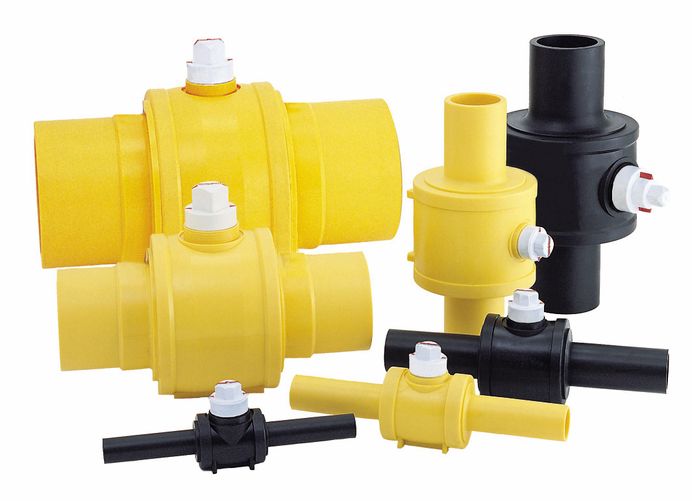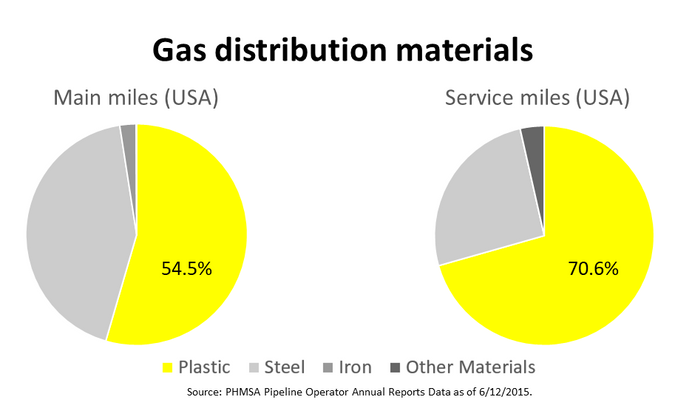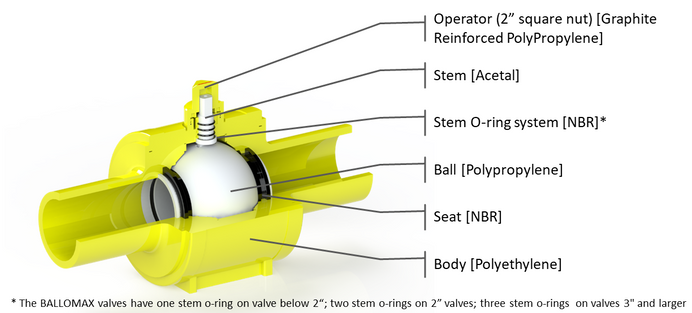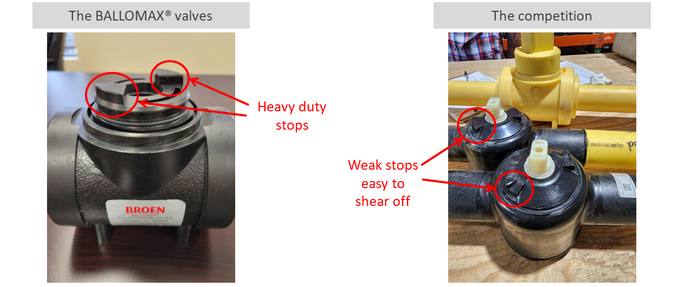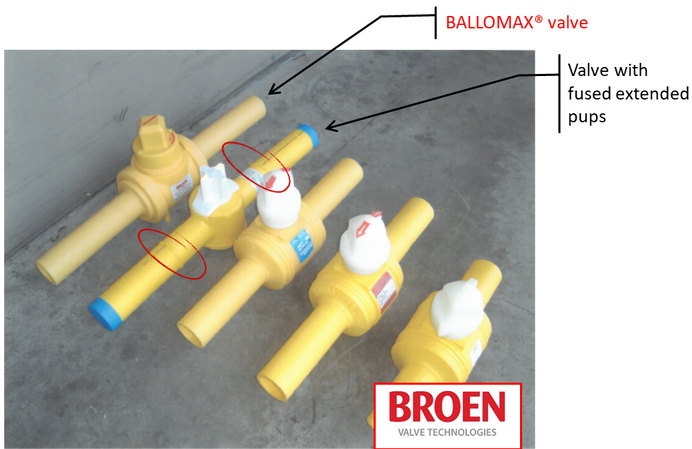Technical Training on Polyethylene (PE) Ball Valves
Goals for this module
- Introduce into the use of Polyethylene materials for gas distribution
- Explore the main quality standards for Polyethylene Ball valves for Gas service
- Understand the key features of PE ball valves
------------------------------------------------------------------------------------------------------------
WHY POLYETHYLENE MATERIALS IN GAS DISTRIBUTION
Did you know that plastics (mainly PE) are the most used materials in Gas Distribution systems in North America?
The reason behind the successful use of PE lies in the several advantages that PE has over steel and other metallic materials:
- PE is not subject to corrosion. It is chemically resistant and does not cause any contamination to the fluid transported inside the system.
- PE is a low friction material, therefore minimizing the pressure drop inside the piping system.
- PE is flexible, therefore easy to transport (in coils) and install, without the need of welding fittings and extensive excavations.
- PE is lightweight, therefore easy to handle (including transportation).
- PE has an extra-long life expectancy.
- PE is cost competitive.
Despite these many advantages, PE offers some limitations:
- PE is subject to UV degradation, therefore it is recommended for buried service or for installations inside buildings. It cannot be used when exposed to the sunlight.
- PE is limited in the maximum pressure it can withstand: PE materials are rated for up to 80/125/140 psi (depending on materials and regulation) and it cannot be used for higher pressure.
- PE is limited in the temperature range it can withstand.
- The temperature range for the BROEN BALLOMAX valves is -28.9˚C/-20˚F up to 60˚C/140˚F
- PE piping materials are limited in sizes.
- The 16" BROEN BALLOMAX valves are the largest in the industry.
- PE materials are more fragile, therefore more susceptible to damage by construction activities.
- PE piping is not easy to detect by itself in underground service.
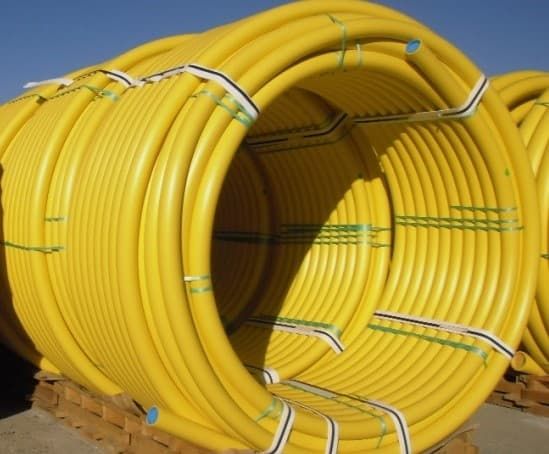
------------------------------------------------------------------------------------------------------------
THE MAIN QUALITY STANDARDS FOR POLYETHYLENE BALL VALVES
To ensure that PE ball valves are fit for purpose and safe to use, American gas companies require for them to comply with the quality standards developed by internationally recognized organizations. Below you will find a description of the most relevant.
ASME B16.40 - Manually Operated Thermoplastic Shutoffs and Valves in Gas Distribution Systems
This standard defines the requirements in terms of valve materials, configurations, pressure rating, marking, and test.
Regarding test, ASME B16.40 prescribes two sets of tests:
- Production tests: tests to be done on all valves manufactured (100%). They include:
-
Shell Test under water with compressed air as test media (One test at 4 psi (±2 psi) and one test at a minimum of 1.5x design pressure). Requirements: No leaks recorded.
-
Seat Test under water with compressed air as test media (One test at 4 psi (±2 psi) and one test at a minimum of 1.5x design pressure). Requirements: No leaks recorded.
-

- Qualification tests: each basic valve design is qualified by testing randomly selected production valves. They include:
-
Operational torque test. Complete ten fully opened/closed cycles. Requirements: No leakage and operating torque not exceeding approved values.
-
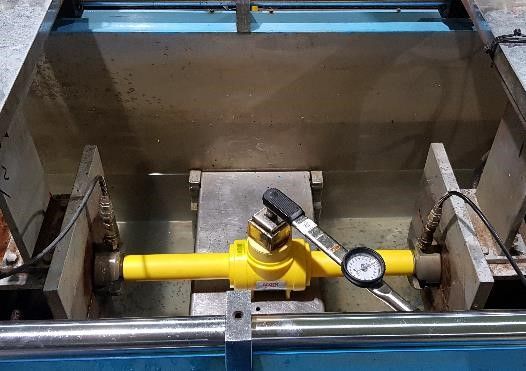
-
-
Temperature resistance test:
-
Low temp.: -20°F for 18 hours. Requirements: No leakage and operating torque not exceeding approved values
-
High temp.: 140°F for 18 hours. Requirements: No leakage and operating torque not exceeding approved values
-
-
Sustained Pressure test:
-
Pressure boundary: 6 valves open and connected, at 176°F for either 1,000 hours at low pressure or 170 hours at high pressure. Requirements: No leakage
-
Valve Closure Test: 1.1x design pressure, for either 1,000 hours at 100°F or 170 hours at 176°F. Requirements: No leakage and valve still operable after test.
-
-
Flow capacity test: pressure loss within approved limits.
-
Impact Resistance: 20lb weight falling from 3 ft on the stem at low (0°F) and high temp (100°F). To be repeated 5 times. Requirements: valves operational with no leaks after test.
-
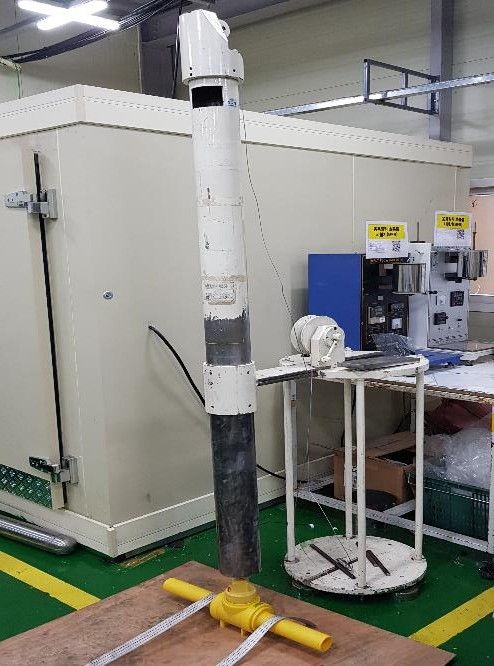
Additional test: X-ray test
Please note that the BALLOMAX PE valves are subject to an additional X-ray test to ensure that the molded materials do not include any voids or inconsistencies. For every production lot, at least one piece is X-ray tested. This test is done on top of those required by ASME B16.40.

ASTM F2897 - Tracking and Traceability Encoding System of Natural Gas Distribution Components (Pipe, Tubing, Fittings, Valves, and
Appurtenances)
This specification defines the requirements for a 16-digit barcode that allows for easy traceability of PE materials used in Natural Gas distribution.
The picture below shows the format of the barcode and the information included in it.
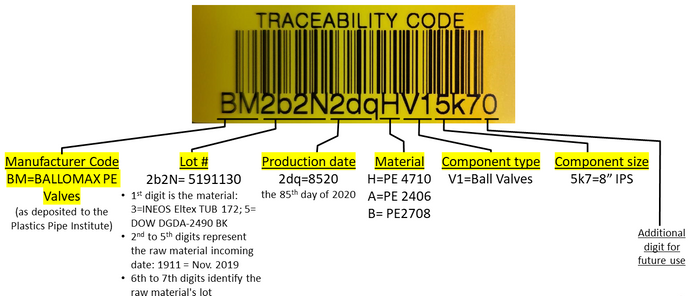

CSA B137.4-13 - Polyethylene (PE) piping systems for gas service
The CSA B137.4-13 standard is the Canadian reference for PE ball valves. Please note that in its section 4.3.1.4.1 it states that PE piping systems shall comply with ASME B16.40. As such, the BALLOMAX PE valves, that meet the requirements of ASME B16.40, can safely be used by the Canadian gas utilities.
------------------------------------------------------------------------------------------------------------
KEY FEATURES OF THE PE BALL VALVES
Materials used
The bodies for PE ball valves are made with two types of resins:
- Medium density/Yellow - PE 2708.
- High density/Black - PE 4710.
It is important that the resins used for the PE body are approved by the Plastic Pipe Institute (PPI). Periodically the PPI releases a technical report (TR-4) that includes all the resins approved for use in the Natural Gas industry. Please check the PPI website for the most updated information.
In the picture below you see the materials used for the other parts in the BALLOMAX PE ball valves:
The benefits of the BALLOMAX PE ball valves
The BALLOMAX PE ball valves represent the state of the art for valves for Gas Distribution.
They have several advantages when compared to their competitors:
- In the BALLOMAX valves there is no metal parts that could create corrosion and compromise the performance of the valve over time.
- The BALLOMAX size range is comprehensive, from 3/4" up to 16".
- The stops in the BALLOMAX valves are heavy-duty and hard to shear off
- The sealing system for BALLOMAX valves in sizes 2" and larger features redundant stem o-rings, to minimize the risk of stem leaks.
- The BALLOMAX valves have extra-long ends to allow for easy handling and multiple fusions, if needed.
- The BALLOMAX valves can be customized with fused pups. This way the gas utilities can specify the pipe they want for the added pups and use their own fusion specs, if they are made for a specific pipe brand.
A BALLOMAX ball valve with fused pups
------------------------------------------------------------------------------------------------------------
Congratulations for completing this training module!
Check your knowledge by taking a test.
You will receive a training certificate by email upon completion.
Start the test by clicking the button below.
------------------------------------------------------------------------------------------------------------
If you have any comments on this training module, please reach out to us at info@broen.com
